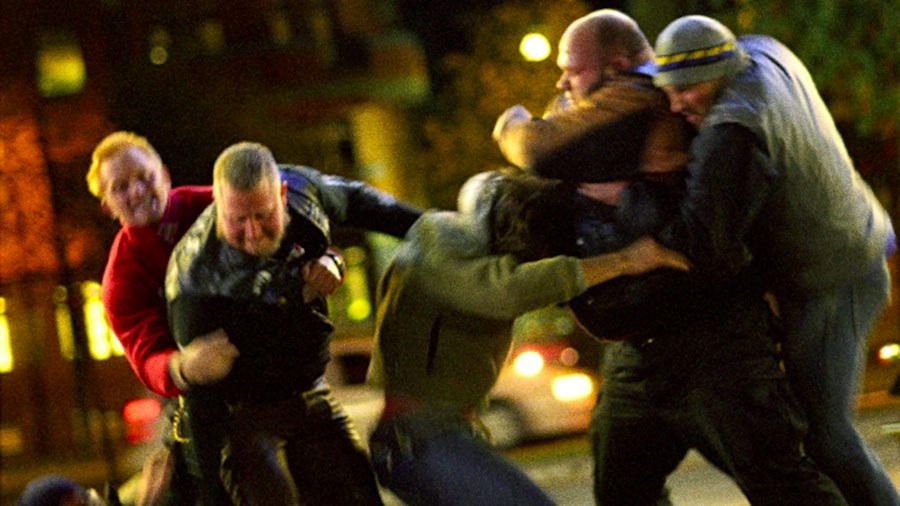
Ruben Östlund’s 2004 debut feature, The Guitar Mongoloid, opens with a short clip of Swedish adult contemporary crooner Lasse Berghagen performing his cheese-ball pop anthem “Stockholm i mitt hjärta” on the annual Allsång på Skansen television broadcast as a crowd of thousands join him in singing along to the song’s blindingly earnest title refrain (“Stockholm is in my heart!”). It’s a humorous bit of sourced footage whose signal is soon interrupted by an unidentified delinquent tearing a satellite receiver off the roof of an apartment building. The literal and figurative static uniting these two scenes, one fiction and one unfortunately not, is a handy metaphor for the darkly comic sensibilities of the Styrsö-born Östlund, who has built his young career thus far on life’s everyday dissonances and the resultant absurdities. But it’s likewise, and perhaps more tellingly, representative of the forty year-old director’s concurrent transition from nonfiction filmmaking to short and feature-length narrative work, two chapters in a catalogue he’s seemingly kept distinct, even as his roots continue to influence and intrude upon his newer films in fascinating ways.

Östlund’s latest film, Force Majeure (2014), was an overdue breakthrough, winning the Un Certain Regard Jury Prize at Cannes and subsequently becoming the first of his four features to date to garner distribution in the Unites States. But while Force Majeure is certainly the director’s most logistically ambitious and universally relatable film to date, it’s also of a concerted piece, both formally and thematically, with his prior work, a logical extension of an endearingly askew worldview. On evidence of Force Majeure, you might say the scale of his vision is now almost inversely proportional to the diminutiveness of his drama, which is likely part of the joke. Writing for Keyframe after first seeing the film, I described it as a modular marriage comedy, a work as carefully composed and structured as its narrative–like the avalanche which precipitates its central couple’s reckoning–is uncomfortable to watch unfold. The key to Force Majeure’s effectiveness–aside from the actors, particularly Johannes Kuhnke and Lisa Loven Kongsli as the harried husband and wife, tasked with reconciling the story’s cutting comedic aspects–is Östlund’s deft handling of a potentially blunt analogy, that minor emotional tremors sometimes do feel like the most catastrophic of events. The film ends with a bus nearly driving off a cliff, reinforcing its message of misjudged perspective while likewise articulating in the most sensational fashion possible the precarious balance that Östlund has somehow managed to negotiate.
Force Majeure was an understandable revelation to most viewers, and yet in many ways it stands as a summation of Östlund’s well-established passions and practices. He spent a full decade prior to The Guitar Mongoloid making ski films and documentaries, and his skill at filming on the slopes and capturing the sheer vastness of an isolated mountaintop locale is in full evidence in the French Alps-set Force Majeure. In fact, the film may be the most accurate, hypnotizing evocation of wintry inertia ever conceived. But Östlund’s past in nonfiction cinema manifests in equally surprising fashion in even his films set closer to sea-level. There’s no other instance in his catalogue of sourced or found footage comparable to the opening of The Guitar Mongoloid, but in the director’s patient, unobtrusive stylistic approach one can often sense the kind of observational interest in his subjects that defines certain sects of nonfiction cinema. The Guitar Mongoloid, for example, finds the director’s camera essentially eavesdropping on a handful of oddball citizens, including the eponymous six-string-toting adolescent, in and around the fictional town of Jöteborg. The slackest of Östlund’s narratives, the film quite purposefully doesn’t amount to much dramatically, opting rather to accumulate a literal and figurative rhythm amongst its various characters (mostly played by non-actors). There’s a loose, improvisatory feel to much of the film, as Östlund allows these townsfolk to endear by will of their own personalities and peculiarities. It’s only by way of the film’s final shot, in which a large, rectangular piece of rubber air padding is sent floating across the skyline as pedestrians look on dumbfounded, that a greater thematic conceit is suggested. And while that theme may not be revelatory, the image itself–something straight out of Roy Andersson–remains striking.

Perhaps inevitably, hints of Andersson, the most celebrated of modern Swedish filmmakers, find their way into the fabric of much of Östlund’s cinema. Like Andersson, he has a knack for capturing life’s many ironies and irregularities. The films themselves, however, are anything but ironic. Östlund appears genuinely fascinated with and sympathetic to his characters, no matter their idiosyncrasies and occasional stupidity. More specifically, he has a preternatural interest in the modern male and the idiocy of the masculine mind. (Tramadol) There is no shortage of arrogant men performing awkward and ill-advised acts in Östlund’s films, and as such he seems tickled to engineer his situational schemas for maximum humor and humiliation. Charting in cyclical fashion a series of five unrelated vignettes, Östlund’s sophomore feature, Involuntary (2008), is at once one of his most conceptually sturdy and downright funny films–and only part of the latter is attributable to a fraternity of young male characters unable to control their impulses and indiscretions. Equal and opposite reactions are encountered when a bus driver becomes perturbed by a broken curtain rod, a pair of teenage girls push their partying past the point of free will, and a young teacher attempts to reprimand an authority figure for an unethical act. There may be a dose of irrationality linking these and many of Östlund’s other stories, but nary a sense of superiority on his behalf. I’d like to believe that the director’s 2005 short, Autobiographical Scene Number 6882, in which a young man foolishly attempts to impress his friends by jumping off a bridge, is indeed autobiographical.

As it did his thematic interests, Involuntary also solidified Östlund’s formal approach. He tends to shoot in long, unbroken takes, rarely (if ever) moving his camera, an aesthetic methodology also likely inherited from Andersson. Such compositional determinism is taken to its most uncomfortable lengths in Play (2011), Östlund’s most provocative film and easily his most troubling portrait of contemporary Sweden. Centered on a group of black adolescents who stage elaborate schemes to swindle other, non-black, teens out of their belongings, the film evolves from a botched theft through a kind of elongated series of confrontations wherein racial preconceptions leave all parties involved at a loss as to how to proceed. Östlund outlines the coordinates of these convergences in fixed frames, as carefully calibrated and choreographed tableau, observing the actions of these kids from a distance but with a tangible curiosity (with this in mind, Östlund’s prior short, Incident by a Bank [2010], comprised of a single eleven-minute shot of a botched bank robbery, feels directly related to its successor, accruing incremental tension as small details pile up in the frame). To create Play’s illusion of chance and immediacy while still remaining dedicated to his chosen aesthetic philosophy, Östlund situates his camera in unlikely places, such as the intercarriage of a moving bus (a common Östlund setting), forcing the viewer’s perspective to reorient itself with every horizontal sweep of the vehicle and thereby allowing his chosen environment to dictate much of the mounting anxiety. Östlund may be an unapologetic formalist, but his compositional rigor seems a conscious aesthetic response to his turbulent narratives. And in that sense, the title Play may relate as much to the games of thievery depicted in the film as it does Östlund’s own formal trickery. In any case, if Östlund’s unassumingly rich filmography has thus far proven anything, it’s that we’re in good hands.



